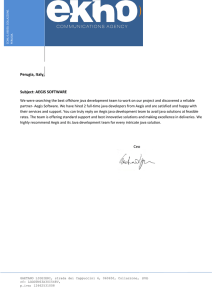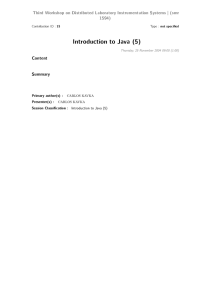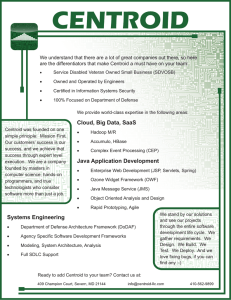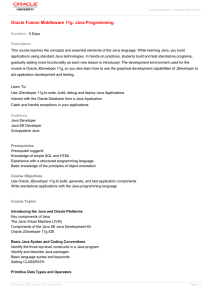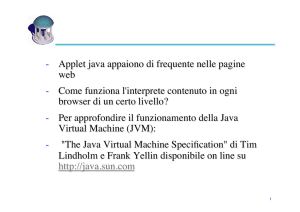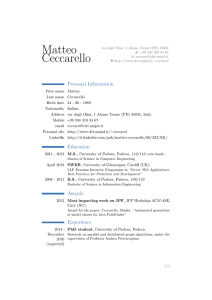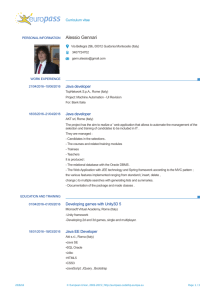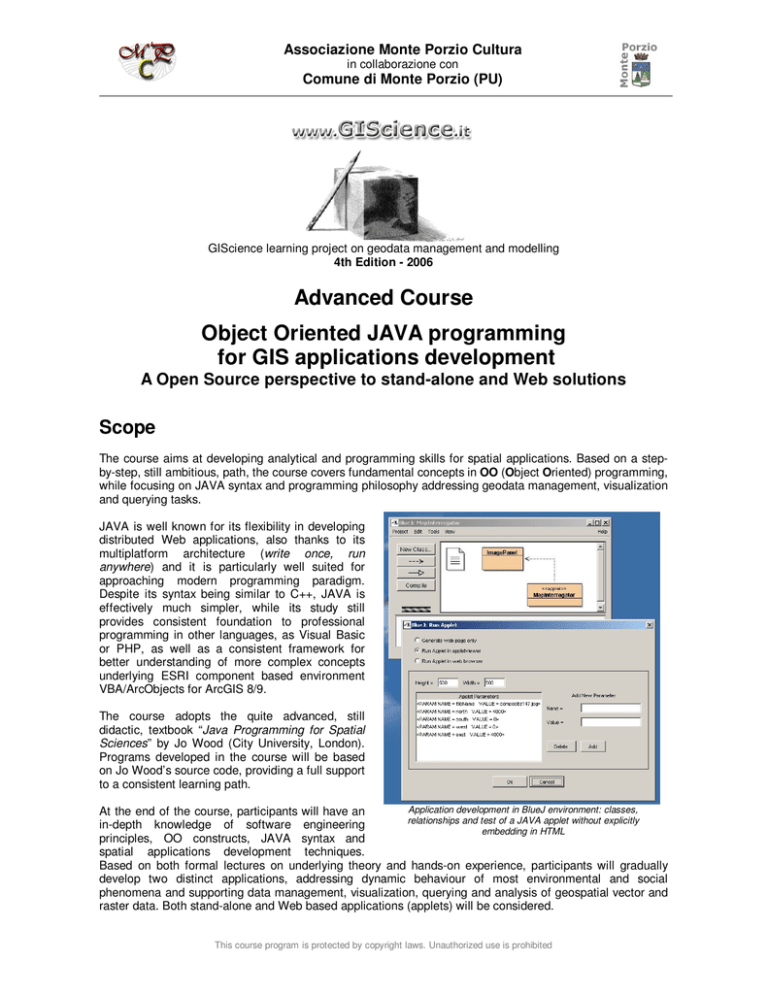
Associazione Monte Porzio Cultura
in collaborazione con
Comune di Monte Porzio (PU)
GIScience learning project on geodata management and modelling
4th Edition - 2006
Advanced Course
Object Oriented JAVA programming
for GIS applications development
A Open Source perspective to stand-alone and Web solutions
Scope
The course aims at developing analytical and programming skills for spatial applications. Based on a stepby-step, still ambitious, path, the course covers fundamental concepts in OO (Object Oriented) programming,
while focusing on JAVA syntax and programming philosophy addressing geodata management, visualization
and querying tasks.
JAVA is well known for its flexibility in developing
distributed Web applications, also thanks to its
multiplatform architecture (write once, run
anywhere) and it is particularly well suited for
approaching modern programming paradigm.
Despite its syntax being similar to C++, JAVA is
effectively much simpler, while its study still
provides consistent foundation to professional
programming in other languages, as Visual Basic
or PHP, as well as a consistent framework for
better understanding of more complex concepts
underlying ESRI component based environment
VBA/ArcObjects for ArcGIS 8/9.
The course adopts the quite advanced, still
didactic, textbook “Java Programming for Spatial
Sciences” by Jo Wood (City University, London).
Programs developed in the course will be based
on Jo Wood’s source code, providing a full support
to a consistent learning path.
Application development in BlueJ environment: classes,
At the end of the course, participants will have an
relationships and test of a JAVA applet without explicitly
in-depth knowledge of software engineering
embedding in HTML
principles, OO constructs, JAVA syntax and
spatial applications development techniques.
Based on both formal lectures on underlying theory and hands-on experience, participants will gradually
develop two distinct applications, addressing dynamic behaviour of most environmental and social
phenomena and supporting data management, visualization, querying and analysis of geospatial vector and
raster data. Both stand-alone and Web based applications (applets) will be considered.
This course program is protected by copyright laws. Unauthorized use is prohibited
Associazione Monte Porzio Cultura
in collaborazione con
Comune di Monte Porzio (PU)
The course is part of a wider GIScience learning project, addressing both introductory and advanced issues,
including a specialization path in environmental applications development and management, with interests
spanning through such different fields as geology, environmental sciences, urban planning, land use, IT, just
to recall few of them.
Program
Detailed course program, based on a mixed theory and hands-on formula, follows::
Introduction to fundamental concepts in OO programming and software engineering
Short introduction to course objectives and structure;
Introduction to procedural and OO programmino from a historical perspective, focusing on relevant
features of JAVA and its key-role in distributed applications development;
Classes and objects. Definitions, development, class state and behaviour, objects instantiation. JAVA
and BlueJ editor: installation, fundamentals and references;
Software engineering, UML fundamentals and guidelines of best practice in code development;
Fundamental types, variables, and typecasting.
Classes development and objects instantiation
Classes vs. objects, objects instantiation,
inheritance,
fundamental
methods
(constructors, accessors and mutators),
parameters passing, abstract methods and
interfaces;
Overview of graphical classes (AWT and
SWING).
Development
of
classical
introductory program Hello. Classes design
face to reusability requirements, relationship
types and code development;
Case study A: design and development of a
class hierarchy after the analysis of an ants
colony dynamic behaviour within a confined
spatial context. Software engineering and
source code development will provide handson evidence of OO concepts, namely
inheritance, composition and interfaces
implementation. The example introduces the
requirements for a conceptual design of a
spatial class to handle the dynamic behaviour
of a single ant.
Flow control
Variables, arithmetic and logical operators,
precedence operators, precision, iterator
controls (for, do while and while do), nested
loops, monodimensional and multidimensional
arrays (declaration and initialization, raster
ImagePanel class source code in BlueJ
model development), design and dynamic
(after: Jp Wood, 2002)
management of graphical components (Flow,
Border e Grid Layout);
Case study B: analysis, design and development of a GUI (Graphical User Interface) to address raster
visualization tasks, by extending native JPanel class. Screen coordinates transformation to
This course program is protected by copyright laws. Unauthorized use is prohibited
Associazione Monte Porzio Cultura
in collaborazione con
Comune di Monte Porzio (PU)
georeferenced framework, colors and dynamic layout management (graphics display, metadata and user
commands).
Decisions management
Decisions management statements: if, if-else, nested if, switch, flow-through, break and default,
conditional operators, guidelines in optimization of program flow control. Basics of sorting and searching
algorithms. Development of a simple class implementing Bubble Sort algorithm.
Case study A: development of a spatial class (Footprint), to manage point or rectangular elementary
vectr geometries. Generalization of raster and vector model by developing a common interface
(SpatialModel). Class variables and elementary topological algorithms analysis and development
(separation, adiacency, intersection, enclosure, coincidence after the simplified classification of
Molenaar, 1998).
Classes sharing
Variables scope (local, method, object and class), modifiers (private, public e protected) to enhance their
visibility. JAVA code documentation via Javadoc, main JAVA libraries (packages as awt, swing, event,
util, io and applet). New packages creation and organization, naming rules to avoid conflicts, paths
management.(classpaths).
Case study A: GUI design based on swing package, using the delegation model of event handling,
relevant to flexibility requirements for extension to alternative approaches (i.e. use of awt and applets). In
the framework of a rigorous OO approach, each class is responsible for its graphical output, focusing on
the 3w (what, when and where) rule.
Objects collections
Modeling of vector spatial objects by using arrays. Theory on dynamic groups creation and management
(iterators and collections - List, Set, Map and their ordered counterparts, SortedSet e SortedMap),
TreeMap and HashMap. Database connectivity fundamentals. Development of a more efficient vector
model based on dynamic collections, by implementino the two new classes GISVector e VectorMap.
Case study A: dynamic behaviour programming of moving, feeding and food transport. Previous model is
extended by adding support to food (energy) and to
a complex ants colony, modelled as an objects
collection. JAVA potentials in modelling dynamic
behaviour is fully investigated,.
Dynamic events control
JAVA delegated events, Threads creation, their
relevance and usefulness in implementation of
GUIs. Analysis of WindowListener interface and
delegated event handling to manage interaction with
GUI. Short programming examples relevant to
analysis of Threads key role in managing regular
time events (Timer class);
Case study B: further improvement of GUI
(Graphical User Interface), to manage visualization
of both vector and raster coverages by implementing
event listeners to keep trace of windows resizing
and mouse querying. Textual metadata integration
within the general framework, local to geographical
coordinates transformation, high quality vector
output management after JAVA2D classes.
Streams, files and errors management
Input and output streams, keyboard standard input,
catching exceptions, opening, reading, writing and
Application running in BlueJ Applet visualizer
(Composite Landsat 147 – Guadalentin valley)
This course program is protected by copyright laws. Unauthorized use is prohibited
Associazione Monte Porzio Cultura
in collaborazione con
Comune di Monte Porzio (PU)
closing of files, GUI interaction with the file system, strings analysis and object serialization.
Case study B: prototype extension to file management, textual files importing, serialization of spatial
objects and additional GUI facilites. Description of ASCII format examples (ArcInfo raster grid and
GRASS generic vector), as well as their serialization and deseriaization.
JAVA distributed Web programming
JAVA Applets, HTML (HyperText Markup Language) fundamentals, Applets calls embedding in Web
pages, parameters passing, security and Browser restrictions. Development of a simple cartographic
applet, with elementary querying functionalities embedded in HTML code..
XML (Extensible Markup Language) foundations, JAVA settings for the XML management, Document
Object Model (DOM). Case studies of stand-alone to Web based application conversion.
GIScience project
The course fits in the framework of a wider learning GIScience project. Supported by high-level professional
and academic profiles focused on the fields of GIScience and Environmental protection and remediation, the
project addresses introductory issues in the GIScience introduction course and in a seminar devoted to
Business Geographics & Geodemographics, and more advanced topics in software engineering and
programming in the two courses on VBA/ArcObjects for ArcGIS 8/9 and JAVA.
The new advanced courses on environmental project management and groundwater flow and transport
modelling focus on the growing environmental market, with its demand for high specialization. These
courses perfectly fit in the project framework, being focused on EISs (Environmental Information Systems)
design and development, including advanced issues as spatial statistics, modelling, ESDA (Exploratory
Spatial Data Analysis) and 3D/time-dependent visualization.
Following a complex and coherent learning path, after principles of traditional part-time and distance learning
philosophy, and thanks to previous 2003-2005 editions experience, the course is based on both formal
classes and self-learning, making course accessibility easier and final learning targets more realistic.
Software
MsOffice™, RDBMS MsAccess™ (www.microsoft.com), JAVA™ (http://java.sun.com) and BlueJ™
(www.bluej.org). Both the interpreter and the language are free and can be downloaded from the above
websites.
.
Who is it for?
Professionals working for both private and public sector interested in planning, environment and
programming for spatial sciences, graduate and post-graduate students in similiar disciplines.
It is required: a deep knowledge of PC/MsOffice™ environment, a personal interest in application
development GIS platforms. No formal programming language knowledge is required, even if it could be
useful a previous experience in basic software customisation.
Experience in GIS platforms like ESRI ArcView 3.x™, ArcGIS 8.x/9™, Geomedia™, Grass™ or Idrisi™ can
be useful in algorithms analysis.
The course requires a strong interest in the subject and the capacity to work at home pursuing the
objectives. The structure and the textbook support this approach by allowing long periods of time between
lessons and by giving a well known reference manual.
This course program is protected by copyright laws. Unauthorized use is prohibited
Associazione Monte Porzio Cultura
in collaborazione con
Comune di Monte Porzio (PU)
Location & dates
The course will take place at the multimedia Centre located in Monte Porzio (PU), where 12 last-generation
PCs are available. The course will have a duration of 56 hours in the period May - October 2006, with 8
hours lessons on fridays and saturdays once a month, except summer time, following a calendar balancing
the needs for didactic continuity and in-depth learning requirements. Lessons calendar is defined as follows:
5-6/5, 23-24/6, 22-23/9 and 7/10
Registration
Registration forms are available at the Administration Office of Monte Porzio Cultura, they can be
downloaded in PDF format or they can be requested via Email at [email protected] or
[email protected].
Course fees are 1200 + VAT (20%) in a unique payment before course starting, or in two payments of 650
+ VAT (20%) each one, at the beginning and in the middle of the course. Fees must be payed by bank
transfer to “Associazione Monte Porzio Cultura”, Account # 000020111416, “BANCA SUASA – Credito
Cooperativo, Filiale di Castelvecchio”, Strada Cesanense, 137 – 61040 Castelvecchio (PU) - ABI 08839,
CAB 68451, CIN J, with the clear statement “Participation in course Object Oriented JAVA programming”. If
10% discount conditions are satisfied, they must be explicitly reported on the registration. Both registration
form and photocopy of bank transfer must be sent by fax to 0721-862724 at the attention of Ing. D.
Guanciarossa.
Participants in previous GIScience courses promoted by the Association, students regularly enrolled in
degree, post-degree and Phd courses at Italian or foreign universities at the moment of registration, as well
as education Institutions, public and private companies enrolling more than one person will benefit of a 10%
discount.
The course will be activated with a minimum of 5 participants, while maximum of 10 participants will be
accepted.
Certificate
At the end of the course, participants attending at least 70% of the lessons will be awarded a Completion
certificate.
Didactic material
The course book provided to each participant is:
Wood J., 2002. JAVA programming for spatial sciences. Taylor & Francis, London, UK.
A rich reference bibiliography is available either in paper and digital format. A web reference is the JAVA™
development section (http://java.sun.com) in the Sun website. Good manuals are also:
Eckel B., 2002. Thinking in Java. Prentice-Hall, 3rd Edition, Scaricabile in forma di E-Book dal sito:
http://www.mindview.net/Books/TIJ/
Barnes D.J. e Kolling M., 2003. Programmare in JAVA con BLUEJ: Introduzione alla programmazione a
oggetti. Addison-Wesley. Pearson Education Italia S.r.l., Milano
For the programming issues related to GIS please consult:
This course program is protected by copyright laws. Unauthorized use is prohibited
Associazione Monte Porzio Cultura
in collaborazione con
Comune di Monte Porzio (PU)
Ormsby T., Napoleon E., Burke R., Groessl C. e Feaster L., 2001. Getting to know ArcGIS desktop:
basics of ArcView, ArcEditor and ArcInfo. ESRI Press (include CDROM con una copia trial a tempo
valida per 180 giorni di ArcGIS)
Burke R., 2003. Getting to know ArcObjects – ProgrammingArcGIS with VBA. ESRI Press, Redlands,
California (include CDROM con la raccolta completa dei modelli di ArcObjects, dati e risultati degli
esercizi)
Info
For further information, please refer to Ing. David Guanciarossa, President of “Associazione Monte Porzio
Cultura”, Email address [email protected] or [email protected] or go to the Contacts section of this
website.
This course program is protected by copyright laws. Unauthorized use is prohibited


